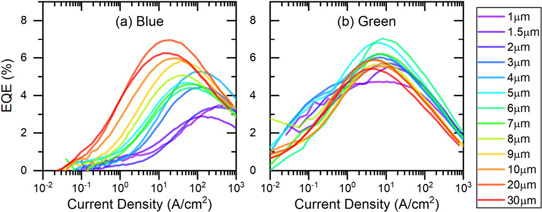A team with researchers at Seoul Viosys and University of California Santa Barbara (UCSB) published a study focuses on features of Micro LEDs as their size goes smaller at 1 to 10 μm.
External quantum efficiency (EQE) of Micro LEDs usually reduces when Micro LEDs get smaller, which becomes an issue for Micro LED technology builders. To further understand the relation between EQE and chip size, a research team of Seoul Viosys and UCSB focus on Micro LEDs down to 1 μm to compare the EQE trend for blue and green InGaN Micro LEDs.
The team published their results on Applied Phyics Letter in February 2020, titled “Comparison of size-dependent characteristics of blue and green InGaN microLEDs down to 1 μm in diameter.”
The team addressed that they only utilized standard semiconductor processing techniques to develop the down to 1 μm InGaN Micro LEDs for the study. They compared blue and green InGaN Micro LEDs and found that green LEDs were more efficient than blue LEDs when they turn smaller than 10μm, meaning that green LEDs were less affected by the size in EQEs.

(Image: Smith et al. 2020)
With the results, researchers also proposed that red InGaN Micro LED may be an approach when manufacturing smaller size full color Micro LED devices.
Based on the study, the team hopes InGaN Micro LEDs with increased brightness and reliability in smaller size can lead to advanced display applications for smartphones, AR glasses and 4K TVs, according to the report covered by Semiconductor Today.
The team also claimed that it is the first study of Micro-LED EQE trends for mesa dimensions below 5μm, despite commercial demands.












